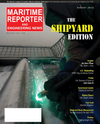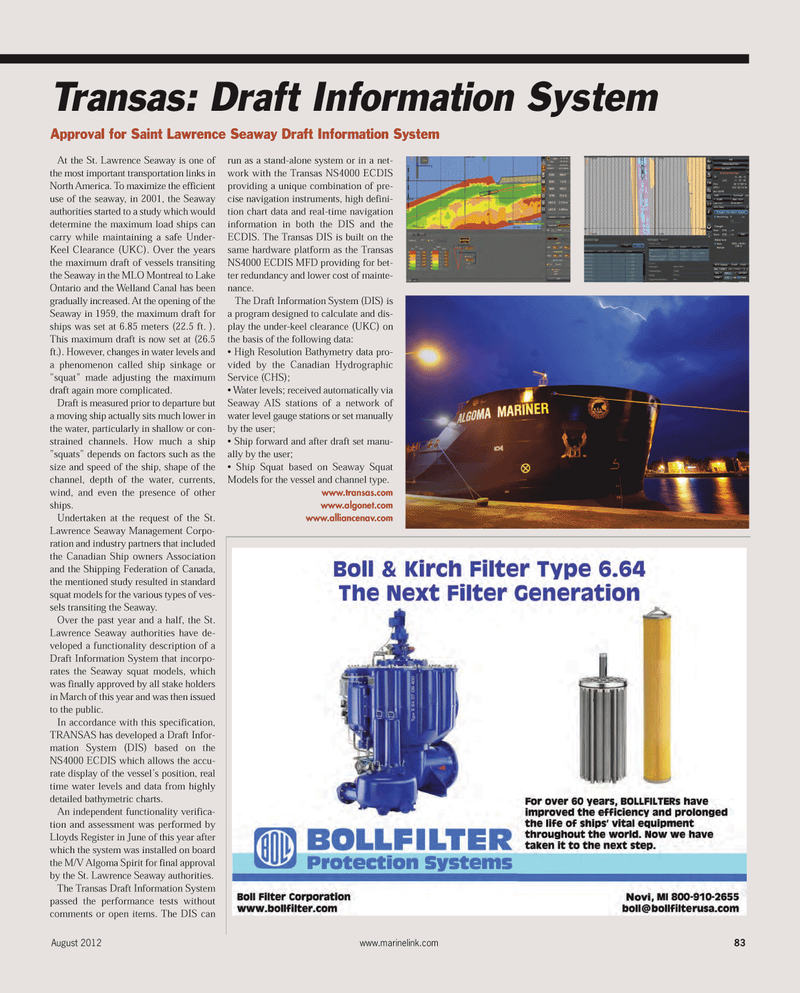
Page 83: of Maritime Reporter Magazine (August 2012)
The Shipyard Edition
Read this page in Pdf, Flash or Html5 edition of August 2012 Maritime Reporter Magazine
At the St. Lawrence Seaway is one of the most important transportation links inNorth America. To maximize the efficient use of the seaway, in 2001, the Seaway authorities started to a study which would determine the maximum load ships cancarry while maintaining a safe Under- Keel Clearance (UKC). Over the years the maximum draft of vessels transiting the Seaway in the MLO Montreal to Lake Ontario and the Welland Canal has been gradually increased. At the opening of the Seaway in 1959, the maximum draft for ships was set at 6.85 meters (22.5 ft. ). This maximum draft is now set at (26.5 ft.). However, changes in water levels and a phenomenon called ship sinkage or"squat" made adjusting the maximumdraft again more complicated. Draft is measured prior to departure but a moving ship actually sits much lower in the water, particularly in shallow or con- strained channels. How much a ship "squats" depends on factors such as the size and speed of the ship, shape of thechannel, depth of the water, currents, wind, and even the presence of other ships.Undertaken at the request of the St. Lawrence Seaway Management Corpo- ration and industry partners that includedthe Canadian Ship owners Association and the Shipping Federation of Canada,the mentioned study resulted in standardsquat models for the various types of ves- sels transiting the Seaway. Over the past year and a half, the St. Lawrence Seaway authorities have de- veloped a functionality description of a Draft Information System that incorpo- rates the Seaway squat models, which was finally approved by all stake holders in March of this year and was then issued to the public.In accordance with this specification, TRANSAS has developed a Draft Infor- mation System (DIS) based on theNS4000 ECDIS which allows the accu- rate display of the vessel?s position, real time water levels and data from highly detailed bathymetric charts. An independent functionality verifica- tion and assessment was performed by Lloyds Register in June of this year after which the system was installed on board the M/V Algoma Spirit for final approval by the St. Lawrence Seaway authorities. The Transas Draft Information System passed the performance tests withoutcomments or open items. The DIS can run as a stand-alone system or in a net-work with the Transas NS4000 ECDIS providing a unique combination of pre- cise navigation instruments, high defini- tion chart data and real-time navigation information in both the DIS and theECDIS. The Transas DIS is built on the same hardware platform as the Transas NS4000 ECDIS MFD providing for bet- ter redundancy and lower cost of mainte- nance.The Draft Information System (DIS) isa program designed to calculate and dis-play the under-keel clearance (UKC) on the basis of the following data: High Resolution Bathymetry data pro- vided by the Canadian HydrographicService (CHS); Water levels; received automatically via Seaway AIS stations of a network of water level gauge stations or set manually by the user; Ship forward and after draft set manu- ally by the user; Ship Squat based on Seaway Squat Models for the vessel and channel type. www.transas.com www.algonet.com www.alliancenav.com August 2012www.marinelink.com 83Transas: Draft Information System Approval for Saint Lawrence Seaway Draft Information System MR#8 (82-89):MR Template 8/13/2012 12:04 PM Page 83

 82
82

 84
84
